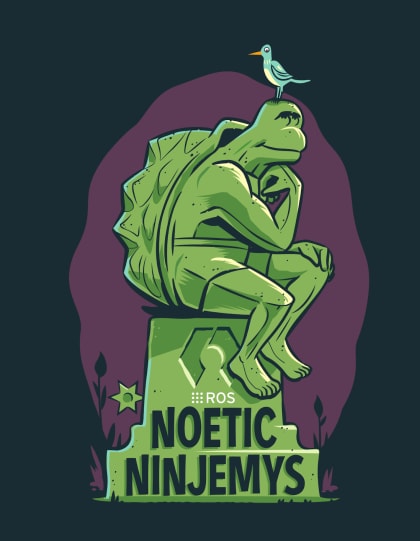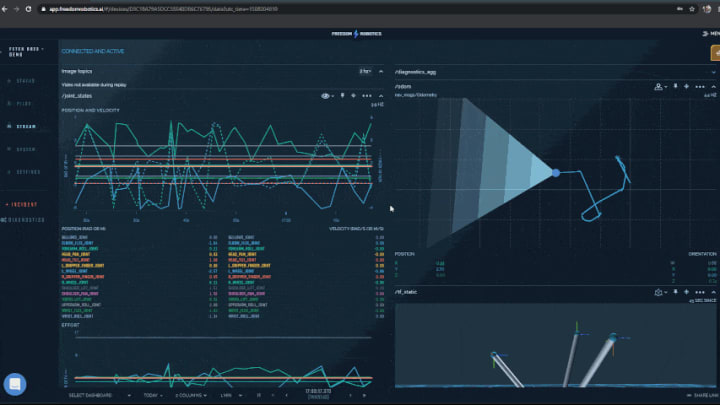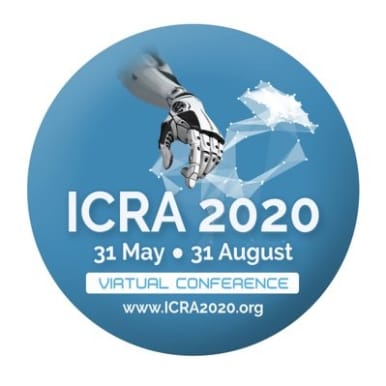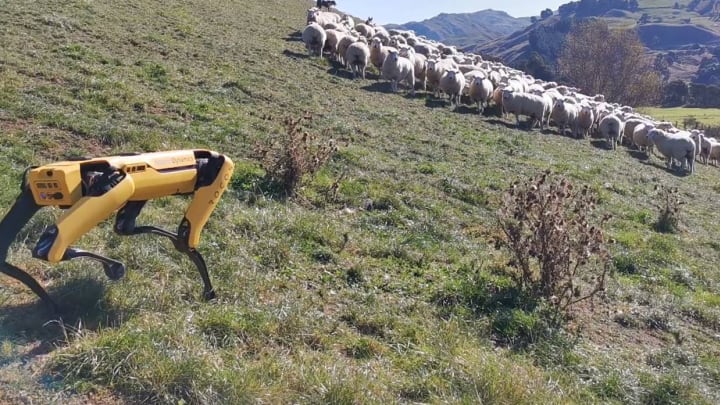The State of Robotics – May 2020
Adi Singh
on 5 June 2020
Tags: may , robotics , ROS , thestateofrobotics
With several countries finally emerging from lockdowns and markets showing signs of economic recovery, we’ve seen the newscycle steadily shift its focus away from Covid-19. And that will be reflected in our robotics recap as well. Let’s get right to it.
Final ROS 1 version release
ROS Noetic Ninjemys was released this month on World Turtle Day. Noetic is the 13th and final release of ROS 1. Ninjemys, incidentally, refers to an extinct species of giant turtle, which makes it a rather apt name for the last version of good ol’ ROS.

Noetic is a long term support (LTS) release which will be maintained until May 2025. It is also the only ROS 1 release to officially support Python 3. Docker images for Noetic are already available. And don’t forget to add the official release T-Shirts to your wardrobe.
Going forward, the robotics community will move its efforts to developing ROS 2.

Naming for ROS 2 G-version underway
As is the ROS tradition, now that we’re nearing the ROS 2 Foxy release date, it’s time to name the G-version of ROS 2. The discussion thread has received a ton of suggestions. Our favorites so far are Galactic Gamera, Grumpy Gopherus, and Gutsy Gibba.
Head over to the Discourse page to provide your own recommendations. Something to keep in mind – not every user is a native English speaker, so the best release names are easy to pronounce. Glacial, glorious and global are quite practical. Glamorous, groundbreaking and geosynchronous… not so much.
Project of the Month
Have you noticed how many robots simulate real-life creatures? Not only does biology lend itself to inspiration in robot design, it also provides us with a finely tuned, optimized model to emulate. The Memory of Motion (memmo) project is an example of biomimicry in robotics. Specifically, in this case, complex movements in unstructured environments are planned using the cognitive principles from human biology.
Optimal motion plans are pre-computed offline, and then recalled when needed in real-time training. Training feeds back on continued optimisation of the motion plans. This planning workflow follows the cognitive model for human situational awareness where training and experience is used to create models, and models speed selection of actions to drive towards a goal.
The snappy TurtleBot continues
Canonical engineer Jeremie Deray continued his work on snapping a TurtleBot3 robot. In this series, Jeremie discusses and demonstrates how users can build and upload a snap for a functioning robotics system.

The demo snap is available in the snapstore, so if you’d like to see what it’s like to set up an entire robot in a matter of seconds, open a SSH connection in a terminal to your Pi3 and type
sudo snap install turtlebot3cLink ROS announced
San Francisco based startup Freedom Robotics announced Link ROS, which is their take on a tool for cloud logging, data visualization, and tele-operation for robotics. It enables viewing data coming from ROS 1 or 2, and controlling robots from anywhere in the world, even with choppy internet connectivity.

This tool should be pretty nifty for remotely debugging robots or taking action when a deployed robot goes down in the browser. Check out more about this project here.
ROS 2 Vuln Disclosure Policy published
Are you aware of a vulnerability in ROS? ROS now has a Vulnerability Disclosure Policy to guide you through the reporting process. The ROS 2 Security Working Group, chaired by Canonical’s Joe McManus, drafted a vulnerability disclosure policy which was formally released this month as ROS Enhancement Proposal (REP) 2006. The release of the REP once again demonstrates the ROS community’s commitment to security as the program continues to mature.
ICRA reimagined as a virtual conference
The International Conference on Robotics and Automation (ICRA) 2020 – billed as the largest robotics meeting in the world- is being held virtually for the first time this year. The conference began on May 31 and will be running through June 15.

The new virtual format has its advantages. Besides attending the entire event from the comfort of your home, all recorded content will be available through August 31. Gone are the days of running between rooms to catch your next talk. The vast majority of papers are being presented via pre-recorded 5- to 10-minute videos that registered users can watch on-demand.
Man’s new best friend 2.0
Boston Dynamics’ pushed a major software update to its robot dog prototype, otherwise lovingly known as Spot. Spot 2.0 brings enhanced mobility, communications, navigation and additional payload support to users. It also offers developers a new set of APIs to access a broader variety of autonomous behaviors on the robot, making application prototyping easier and more powerful.
We’re already seeing some interesting applications of this platform in the field. Singapore deployed Spot for patrolling public parks and broadcast messages to people in an effort to enforce social distancing. And in New Zealand, the platform is being tested to autonomously herd sheep through difficult and mountainous terrain.

Software company Rocos partnered with Boston Dynamics to herd sheep in New Zealand. (Source: stuff)
The technology onboard a Spot 2.0 is absolutely cutting-edge (and correspondingly expensive). But if all you’re interested in is having a cute robot dog to shake paws with, try making one of your own by following this handy Instructable from Daniel Hingston.
Boston Dynamics’ pushed a major software update to its robot dog prototype, otherwise lovingly known as Spot. Spot 2.0 brings enhanced mobility, communications, navigation and additional payload support to users. It also offers developers a new set of APIs to access a broader variety of autonomous behaviors on the robot, making application prototyping easier and more powerful.
Open source to the rescue
The open source robotics community has been crucial in the battle against coronavirus. Face shields and ventilators made by open source developers have been invaluable to hospitals. A UV disinfection prototype was built using a TurtleBot within a 24-hour period. And several proprietary systems deployed in hospitals and airplanes rely on open-source IoT and robotics tools.
It is no wonder that the last couple of months have seen a large influx of investment into automation and robotics that can thrive in a post-covid economy. Brain Corp raised $36 million to bring autonomy to mobile robots for cleaning and materials handling. Intellifusion pulled in $141 million to develop vision processors for AI in robotics and autonomous vehicles. Covariant raised $40 million to bring robotics to low-cost industries for preventing future supply chain disruptions. And Dishcraft received $20 million to help restaurants reopen safely by building a fleet of robots that clean up to 10,000 pieces of dishware overnight.

Necessity is the mother of invention, and the needs exposed by the pandemic are spurring on some very interesting innovations in the area of robotics. Expect this trend to continue.
Outro
At Canonical we are privileged to have a well-established pattern of remote work and have been glad to help others by sharing our experience of distributed collaboration and operations. Our official commercial stance is, please lean on us, we stand ready to help.
As for all the makers and hackers out there, if you have an open-source project or initiative you’d like us to showcase in this monthly series, shoot us a message on robotics.canonical@canonical.com. We’ll take it from there. That’s it folks, stay safe in June!
Talk to us today
Interested in running Ubuntu in your organisation?
Newsletter signup
Are you building a robot on top of Ubuntu and looking for a partner? Talk to us!
Related posts
Discover your fully open source robotics observability at ROSCon 2025
Another year, another ROSCon! This year we’re heading to Singapore, and Canonical is once again thrilled to sponsor this important community event. Just like...
Canonical is now a platinum member in the Open Source Robotics Alliance
Ubuntu is the home of ROS. The very first ROS distribution, Box Turtle, launched on Ubuntu 8.04 LTS, Hardy Heron, and since then, Ubuntu and ROS have grown...
ROS Noetic is EOL – take action to maintain fleet security
As of May 2025, the Robot Operating System (ROS) Noetic Ninjemys officially reached its end of life (EOL). First released in 2020 as the final ROS (1)...

